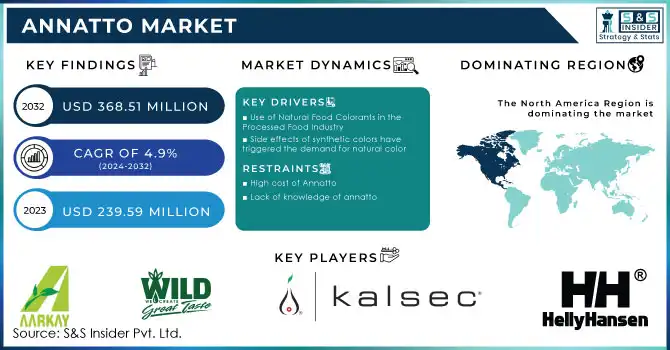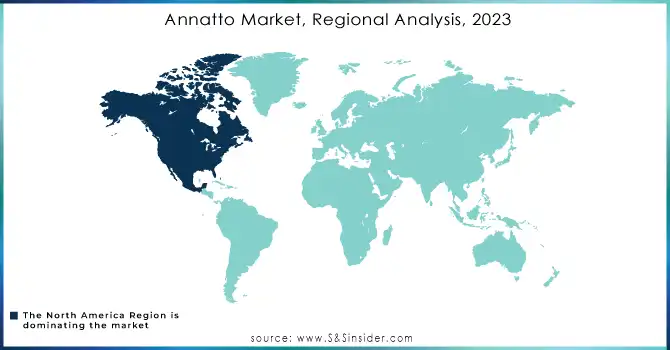Annatto Market Report Scope & Overview:

Get More Information on Annatto Market - Request Sample Report
The Annatto Market size was valued at USD 239.59 million in 2023 and is expected to grow to USD 368.51 million by 2032, at a CAGR of 4.9% over the forecast period of 2024-2032.
Achiote seed extracts, commonly known as annatto, are among the oldest natural dyes available to humans and are widely utilized as a natural food colorant in the food business. The market's future growth prospects are expected to be driven by rising applications throughout the food and non-food industries.
Based on Type, the annatto market is segmented into Solvent Extraction, Aqueous Extraction, and Emulsified. Water-soluble and emulsified product types dominate the market due to their wide application spectrum. This segment is frequently utilized in dairy products. With the recent establishment of free-form products in the dairy sector, the use of emulsifier pigments will grow more lucrative and profitable for producers.
The food industry segment dominates the application segment due to the rising demand for natural food colorant ingredients. Annatto is on the list of approved colors for the food industry by the European Union, the Food and Drugs Administration of the US, and the World Health Organization. Annatto seeds are used to produce red-orange to brown colors in the food industry. Annatto’s major coloring component, Bixin, produces a vivid color when dissolved in oil. This ingredient contributes to the consistency and stability of food items by imparting a rich appearance and flavor.
MARKET DYNAMICS
KEY DRIVERS
-
Use of Natural Food Colorants in the Processed Food Industry
Natural food colorants are in high demand due to a variety of variables, including the growing awareness of the health hazards posed by synthetic food colorings. Also, Organic and natural foods are becoming increasingly popular. As the demand for natural colorants rises throughout the forecasted period, so will the use of annatto, which naturally produces a distinctive red/orange color. Annatto is a natural colorant that gives margarine, butter, and cheese its yellow color. It's also found in a variety of commercial products, including smoked fish, processed meats, processed meals, beverages, and various packaged foods.
-
Side effects of synthetic colors have triggered the demand for natural color
RESTRAIN
-
High cost of Annatto
Annatto has lower stability when compared to synthetic colorants such as Allura Red, Azorubine, and others. Furthermore, synthetic colorants are frequently less expensive than natural colorants and can be made in huge quantities. To make and market annatto products, firms must invest a significant amount of money. This makes them more appealing to many producers. The high cost of annatto is a significant barrier to market growth.
-
Lack of knowledge of annatto
OPPORTUNITY
-
Increasing consumption in the cosmetics industry
The rapid rise of the organic and plant-based industries has piqued consumer interest in natural components in skincare and cosmetics. Furthermore, consumer awareness of chemical-free and organic products boosts market growth. Annatto is a natural colorant derived from the achiote tree's seeds. It is used to give a yellow to orange-red hue to cosmetics such as lipsticks, lip balms, blushers, and eye shadows.
CHALLENGES
-
Strict government regulations
Governments frequently impose strict safety criteria for annatto-containing foods and cosmetics. This can make compliance with rules difficult and costly for enterprises, discouraging them from utilizing annatto. The United States has rigorous rules for food colorants due to rising instances of foodborne disease and increased demand for safe food items free of unpleasant food additives.
IMPACT ANALYSIS
IMPACT OF RUSSIA-UKRAINE WAR
Russia and Ukraine are the largest producers of annatto. The Russian food sector is expanding following previous crises that left the country heavily reliant on food imports from other countries. Since the commencement of the war, the supply chain of annatto materials has been disrupted which has led to an increase in the price of annatto in the United States has grown by 25% in 2022. This is because the United States imports the majority of its annatto from Russia and Ukraine. The war has led to a price rise of 10% globally.
IMPACT OF ONGOING RECESSION
The recession has impacted the annatto market. The 2022 recession is predicted to decrease in demand for annatto by 5%. This is because manufacturers will probably try to minimize expenses, and using less expensive colorants and look for alternate colorant materials. The US is the largest market for annatto. The majority of the annatto that the United States buys comes from other countries that are also going through a recession. During the recession, the demand for annatto in Brazil is anticipated to fall by 17%. This is because Brazil is a significant annatto consumer, and the recession is anticipated to have an effect on the economy of that country.
KEY MARKET SEGMENTATION
By Type
-
Solvent Extraction
-
Aqueous Extraction
-
Emulsified Annatto
By Application
-
Food & Beverage
-
Fabric Industry
-
Cosmetic Industry
-
Other
REGIONAL ANALYSIS
North America has the greatest market share for the annatto market. This is attributed to growing government support for the use of natural food colors in a variety of food and beverage applications is likely to drive the annatto market in this region. According to the Food and Agriculture Organization, the United States is the world's largest annatto market, accounting for roughly 42% of global imports. It gets more than 61% of its supplies from Peru and the rest from the Caribbean region.
The Asia Pacific market is predicted to grow rapidly at 5.8 % CAGR due to rising consumer knowledge about the usage of natural food flavors and coloring, as well as an increasing number of product launches using natural colors. Furthermore, increased health consciousness, the appeal of clean-label products, favorable food safety requirements, and significant R&D investments are driving the industry forward.
Europe holds a significant market share for the annatto market due to the large consumer demand for natural food coloring in food and beverage items, Additionally, the production of caramel uses annatto in enormous quantities, which fuels the expansion of both regional markets. Stringent rules of Europe on the application of food color in the food industry.

Need Any Customization Research On Annatto Market - Inquiry Now
REGIONAL COVERAGE
North America
-
US
-
Canada
-
Mexico
Europe
-
Eastern Europe
-
Poland
-
Romania
-
Hungary
-
Turkey
-
Rest of Eastern Europe
-
-
Western Europe
-
Germany
-
France
-
UK
-
Italy
-
Spain
-
Netherlands
-
Switzerland
-
Austria
-
Rest of Western Europe
-
Asia Pacific
-
China
-
India
-
Japan
-
South Korea
-
Vietnam
-
Singapore
-
Australia
-
Rest of Asia Pacific
Middle East & Africa
-
Middle East
-
UAE
-
Egypt
-
Saudi Arabia
-
Qatar
-
Rest of Middle East
-
-
Africa
-
Nigeria
-
South Africa
-
Rest of Africa
-
Latin America
-
Brazil
-
Argentina
-
Colombia
-
Rest of Latin America
KEY PLAYERS
The Key Players are Aarkay Food Products, WILD Flavors, Kalsec, Hansen, FMC, DDW, Frutarom Natural Solutions BU, Amerilure Inc, AICA-COLOR, Biocon del Peru, DDW, Chr. Hansen Holding A/S, and other key players.
RECENT DEVELOPMENTS
In 2023, Sun Chemicals' SunPrizma color-travel range and glittering silver Reflecks Dimensions Platinum G13CD made their debuts at in-cosmetics Global, where the business also showcased its newly introduced SunPuro Naturals line. SunPURO is a new brand of natural colorants and useful compounds produced by plants. Naturals The collection contains two orange-red items made from ethically obtained annatto, two traceable green chlorophyll ingredients, an upcycled black colorant made from coconut shell waste, and a milky opacifier made from responsibly sourced milk.
In 2022, Sun Chemical expand natural Colorants for Cosmetics and Personal Care in its product portfolio by offering SunPuro Natural Annatto A and SunPuro Natural Annatto O.
In 2022, Sun Chemical introduced Sunfood's natural colorants, a series of naturally sourced colors that may be used in a wide range of food and beverage items. Colors will be accessible throughout Europe, the Americas, the Middle East, and Africa.
| Report Attributes | Details |
| Market Size in 2023 | US$ 239.59 Million |
| Market Size by 2032 | US$ 368.51 Million |
| CAGR | CAGR of 4.9% From 2024 to 2032 |
| Base Year | 2023 |
| Forecast Period | 2024-2032 |
| Historical Data | 2020-2022 |
| Report Scope & Coverage | Market Size, Segments Analysis, Competitive Landscape, Regional Analysis, DROC & SWOT Analysis, Forecast Outlook |
| Key Segments | • By Type (Solvent Extraction, Aqueous Extraction, and Emulsified) • By Application (Food & Beverage, Natural Fabric Industry, Cosmetic Industry, Other) |
| Regional Analysis/Coverage | North America (US, Canada, Mexico), Europe (Eastern Europe [Poland, Romania, Hungary, Turkey, Rest of Eastern Europe] Western Europe] Germany, France, UK, Italy, Spain, Netherlands, Switzerland, Austria, Rest of Western Europe]), Asia Pacific (China, India, Japan, South Korea, Vietnam, Singapore, Australia, Rest of Asia Pacific), Middle East & Africa (Middle East [UAE, Egypt, Saudi Arabia, Qatar, Rest of Middle East], Africa [Nigeria, South Africa, Rest of Africa], Latin America (Brazil, Argentina, Colombia Rest of Latin America) |
| Company Profiles | Aarkay Food Products, WILD Flavors, Kalsec, Hansen, FMC, DDW, Frutarom Natural Solutions BU, Amerilure Inc, AICA-COLOR, Biocon del Peru, DDW, Chr. Hansen Holding A/S |
| Key Drivers | • Use of Natural Food Colorants in the Processed Food Industry |
| Market Restrain | • High cost of Annatto |

